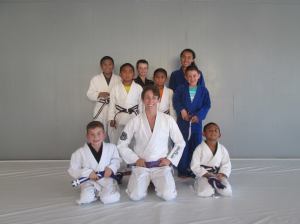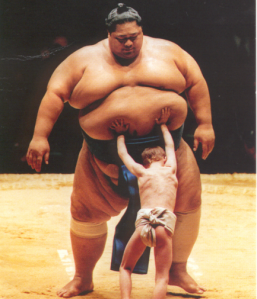Blog Archives
Train Like a Kid
As I was teaching our FVGC Advanced kids jiu-jitsu class the other day, I looked around the room as the kids were drilling technique and felt proud! It was a class of 6-12 year olds repping their techniques with beautiful movement and great discipline. They hardly needed any tries to “get it right”. During rolling they stayed controlled and calm, hardly ever relying on size or strength to gain position or get the submission. It occurred to me in that moment that in some ways it was easier to teach this class than the adult white belts, that the adults have a harder time smoothly doing technique and rolling with some flow.
 How is this possible? Here are 3 reasons I came up with:
How is this possible? Here are 3 reasons I came up with:
- Kids come in with little to no pre-conceived ideas about BJJ: Usually kids come into class not knowing what jiu-jitsu is or how it should look. So, they come into class and take the instructor’s word for how things should be done and mimic the body movements and style of those that know more than they do. They don’t over-think it; they just DO IT.
- They work with adult instructors: The first time our kids roll, it is with an adult that is much larger than they are; perhaps this gives them the idea that their size and strength cannot be relied on all the time. They are forced to use good technique, as an instructor won’t let them get away with anything else!
- They keep it fun! Ego is much less of a problem in the kids’ classes. Of course, there is always some healthy competition, but the kids take it to heart when an instructor says, “You are going to have bad days rolling. It is okay. It happens to everyone. Everyone makes mistakes, and that is why you keep coming to class”. Even a child that has a rough practice is over it in about 10 minutes and ready to come back for their next class.
So I guess my advice is….Train like a kid! Come to class like a sponge, ready to absorb; roll with people that are bigger or more experienced than you; and, don’t let your ego get in the way of your training. Open your mind, open your heart, and LOVE JIU-JITSU!
Happy Training! 🙂
The Jiu Jitsu Body
I spend a lot of time at the gym both watching and participating in Jiu jitsu classes here in Appleton. During these times, I hear a lot of discussion regarding body type and jiu jitsu. Even the kids in our BJJ program have realized that body type makes a huge difference. Many times the discussion is more of a complaint than anything…
 “My legs are too long to fit the hook in”
“My legs are too long to fit the hook in”
“I am not strong enough to bump him”
“I am not flexible enough for this move”
“I can’t lock my guard/touch my knees to the floor in mount”
And then, there is the speculation that “That guy has the perfect jiu-jitsu body!”
The fact of the matter is that there is no such thing as a perfect jiu-jitsu body. Every body type has its advantages. Tall and lean is great for the guard. They may not be big and strong, but small guys can ball up, move fast and fluidly, and take advantage of little spaces. Those that aren’t that naturally flexible tend to take up a strong pressure and passing games. You must use what nature gave you and work with it! Not every move shown in class is going to be perfect for your game or be your #1 move; we all pick and choose. If you like to watch jiu jitsu videos, it may be a good idea to find someone that shares your body type!
That being said, remember that if you are frustrated with a certain technique or training partner, your body type may not be to blame! You may be missing details, a frame here or a hip movement there, or may need to modify your strategy…it’s probably something that your instructor can help you with!
The Right Frame of Mind: Getting Through Your First Practice
Once upon a time, there was a man who decided he wanted to try to play basketball. He had never played before, but thought it was a cool sport that would be fun and help him get into shape. He imagined himself flying down the court with ease, getting the ball and making the perfect jump shot. It was beautiful. He found a rec league to play with and attended his first practice. It was harder than he imagined; he was out of breath and had trouble handling the ball, let alone making a basket. In fact, the other players left him in the dust. The man decided that basketball wasn’t a good sport for someone like him and quit after one practice.
We see this a lot in our Brazilian jiu-jitsu class here in Appleton. We have a lot of people come in with absolutely no real experience and/or a low fitness level wanting to try the class. Very quickly they realize that the warm-ups alone are tough.Very quickly they realize that they don’t know anything, especially compared to the other people around them. Very quickly they realize the time and work it will take to see even the most basic positions and get their BJJ strength and cardio up.
And this is the crossroads. Will they have patience with themselves and realize that it was everyone’s first day at one time? Will they come back to the next practice and see what else they can learn and start chipping away at getting the basic positions down? Or will they decide that Brazilian jiu jitsu is not a sport that is for someone like them, inexperienced and out of shape?
Jiu jitsu is for everybody! It is for you if you are willing to judge yourself by your own personal progress, rather than in comparison to others. It is for you if you are willing to work hard at it and do your personal best. Michael Jordan didn’t come out of the womb as the best basketball player of all time. He looked as most everyone else the first time he held a basketball. If you come to Brazilian jiu-jitsu thinking you are going to be a superstar on your first day, you are going to be disappointed. But, it is not the sport….it is your frame of mind!
Train Hard!
Go with the Flow: Exercise Ball Cross-Training for Brazilian Jiu-jitsu
There are a lot of different ways to cross train. One tool that has changed my Brazilian jiu-jitsu game is the exercise ball (also called a stability ball). If you have never seen an exercise ball used for Gracie jiu-jitsu, check out this video (sorry for the weird music…the guy knows how to move, but may need some help with his soundtrack choices):
I love the exercise ball for jiu-jitsu because it teaches a lot of different principles.
1) Balance and flow come from RELAXING the right parts of your body: If you are tense, you will lose your balance. The ball will “sweep” you. You need to relax the majority of your body and make minor adjustments to keep the main balance point. This is also helpful with your jiu-jitsu because it conserves energy and allows you to roll better longer.
2) A lot of CONTROL comes from your HIPS: You control the ball with your hips. You determine the direction it can roll and the places it will stop. This is a great concept for top positions in BJJ: Your hips create pressures and barriers for your opponent when you are rolling!
3) Mistakes happen, but you can MITIGATE the consequences if you FLOW: Tensing up and holding onto a bad position or base will get you swept or subbed. If I relax and counterbalance the mistake I may be able to salvage the position, deter my opponent’s game plan, or go to the next best position. I need to flow instead of panic.
Get started! There are a lot of videos out there to give you some ideas of where to start. You can also just start experimenting on your own, even if it is just starting with basic balancing positions (butt, stomach, knees). Have fun!
FVGC Instructor Spotlight: James Peterson
Okay, who are you and what do you do?
I’m James Peterson and I do whatever the hell I want. Just kidding. I win tournaments. And teach adult and kids Brazilian jiu-jitsu at Team FVGC.
How long have you been training in the martial arts?
I wrestled in high school and a year in college. I have been training BJJ for almost 12 years. I trained MMA for a while, but stopped doing that to concentrate entirely on BJJ coaching and competition.
What do you consider your greatest martial arts accomplishment?
Winning the Pan-Ams twice, once as a blue belt and once as a brown belt. Each one is special for different reasons. Winning as a brown belt was great because it is such a high level belt; but winning at blue belt was awesome too because I submitted all of my opponents.
What were the most important aspects of your preparation for that accomplishment? That is, what were you doing to achieve your goal?
There was a lot of mental training that went into those wins. Even when I was training physically, like doing road work, I would be mentally running through matches in my head. The winning took place far in advance of the actual matches. I was also trying to train with as many high level guys as I could. I took a lot of beatings; a lot of subs. But I had to just take each of those as learning experiences and not look at them as the whole of my game. Oddly, I developed confidence through that adversity that I carried with me to the Pans.
What makes a great martial artist?
Great technique, thoughtfulness, and humility.
Who inspires you?
My family, my coaches and my team.
Any words of advice for people training now?
Always be learning. Learn from your instructors, from books, videos and whatever else you can learn from. If you are really interested in your art, then you should constantly be striving for improvement and trying to advance your skills. Study broadly. I mean, not just the study of your martial art, but other martial arts and other facets of life as well. Also, try to understand your performance moves in cycles. There will be times when it seems like you are not only not improving, but backsliding as well. That is not the case. If you are still learning and taking in information, it just means your body has not caught up to the contents of your brain. You should actually be looking for an upswing in your game in the very near future. Finally, have fun. If you are not having fun, then what’s the point of doing it at all?

